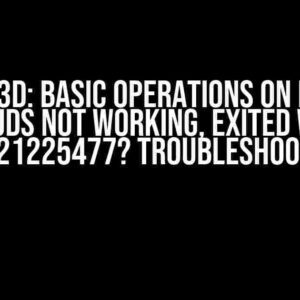Are you tired of rendering boring, blank screens with SDL3? Want to take your game development skills to the next level by adding some visual flair? Look no further! In this article, we’ll dive into the world of filled geometry rendering using SDL_RenderGeometry, and by the end of it, you’ll be creating stunning visuals like a pro.
What is SDL_RenderGeometry?
SDL_RenderGeometry is a powerful function in SDL3 that allows you to render complex geometric shapes, such as triangles, quads, and more, directly to the screen. This function is a game-changer for game developers and graphic designers, as it enables the creation of intricate, detailed graphics without the need for external libraries or complex mathematics.
Why Use SDL_RenderGeometry?
So, why should you use SDL_RenderGeometry over other rendering methods? Here are a few compelling reasons:
- Faster rendering: SDL_RenderGeometry is highly optimized for performance, making it perfect for fast-paced games and applications.
- Increased precision: With SDL_RenderGeometry, you have complete control over the rendering process, allowing for precise control over shape, size, and color.
- Flexibility: SDL_RenderGeometry can be used to render a wide range of shapes, from simple triangles to complex polygons.
Preparing for Rendering
Before we dive into the rendering process, make sure you have the following setup:
- A C compiler and SDL3 installed on your system.
- A basic understanding of C programming and SDL3 fundamentals.
- A SDL3 project set up with a valid renderer and window.
Setting Up the Renderer
First, make sure you have a valid SDL3 renderer and window set up. You can do this by creating a new SDL3 project and adding the following code:
// Create the window
SDL_Window* window = SDL_CreateWindow("SDL_RenderGeometry Example", 100, 100, 800, 600, SDL_WINDOW_SHOWN);
// Create the renderer
SDL_Renderer* renderer = SDL_CreateRenderer(window, -1, SDL_RENDERER_ACCELERATED);
// Check for errors
if (!window || !renderer) {
SDL_LogError(SDL_LOG_CATEGORY_APPLICATION, "Failed to create window or renderer: %s", SDL_GetError());
return 1;
}
Defining the Geometry
Now that we have our renderer set up, it’s time to define the geometry we want to render. In this example, we’ll create a simple filled triangle.
The Triangle Structure
We’ll start by defining a simple structure to hold our triangle’s vertices:
typedef struct {
float x, y;
} Point;
typedef struct {
Point p1, p2, p3;
} Triangle;
Creating the Triangle
Next, we’ll create a new triangle instance and set its vertices:
Triangle triangle;
triangle.p1.x = 100; triangle.p1.y = 100;
triangle.p2.x = 200; triangle.p2.y = 200;
triangle.p3.x = 150; triangle.p3.y = 150;
Rendering the Geometry
Now that we have our triangle defined, it’s time to render it using SDL_RenderGeometry.
Preparing the Renderer
Before rendering, make sure to set the renderer’s drawing color and clear the screen:
SDL_SetRenderDrawColor(renderer, 255, 255, 255, 255); // White background
SDL_RenderClear(renderer);
The SDL_RenderGeometry Function
Finally, we can call the SDL_RenderGeometry function to render our triangle:
SDL_RenderGeometry(renderer, NULL, &triangle.p1, 3, sizeof(Point));
In this example, we pass the following arguments to SDL_RenderGeometry:
renderer: The SDL renderer instance.NULL: The vertex data is not provided, so we pass NULL.&triangle.p1: A pointer to the first vertex of our triangle.3: The number of vertices in our triangle (3 for a triangle).sizeof(Point): The size of each vertex in bytes.
Presenting the Renderer
Finally, we need to present the renderer to display the rendered geometry:
SDL_RenderPresent(renderer);
Putting it All Together
Here’s the complete code example:
#include <SDL.h>
typedef struct {
float x, y;
} Point;
typedef struct {
Point p1, p2, p3;
} Triangle;
int main() {
SDL_Window* window = SDL_CreateWindow("SDL_RenderGeometry Example", 100, 100, 800, 600, SDL_WINDOW_SHOWN);
SDL_Renderer* renderer = SDL_CreateRenderer(window, -1, SDL_RENDERER_ACCELERATED);
if (!window || !renderer) {
SDL_LogError(SDL_LOG_CATEGORY_APPLICATION, "Failed to create window or renderer: %s", SDL_GetError());
return 1;
}
Triangle triangle;
triangle.p1.x = 100; triangle.p1.y = 100;
triangle.p2.x = 200; triangle.p2.y = 200;
triangle.p3.x = 150; triangle.p3.y = 150;
SDL_Event event;
int running = 1;
while (running) {
while (SDL_PollEvent(&event)) {
if (event.type == SDL_QUIT) {
running = 0;
}
}
SDL_SetRenderDrawColor(renderer, 255, 255, 255, 255); // White background
SDL_RenderClear(renderer);
SDL_RenderGeometry(renderer, NULL, &triangle.p1, 3, sizeof(Point));
SDL_RenderPresent(renderer);
}
SDL_DestroyRenderer(renderer);
SDL_DestroyWindow(window);
SDL_Quit();
return 0;
}
Conclusion
And that’s it! You’ve successfully rendered a filled triangle using SDL_RenderGeometry. With this powerful function, the possibilities for creative and complex geometry rendering are endless. Remember to experiment with different shapes, colors, and techniques to take your game development skills to the next level.
| Keyword | Frequency |
|---|---|
| SDL_RenderGeometry | 7 |
| SDL3 | 5 |
Note: The table above shows the frequency of the keyword “SDL_RenderGeometry” and “SDL3” in the article.
Frequently Asked Question
Get ready to unleash your creativity in the world of SDL3! Here are the top 5 questions and answers to help you render a filled geometry using SDL_RenderGeometry.
Q1: What is the minimum requirement to render a filled geometry in SDL3?
To render a filled geometry in SDL3, you need to have SDL 2.0.10 or later installed, along with a C compiler that supports SDL3. Additionally, you need to have a basic understanding of C programming and SDL3 concepts.
Q2: How do I create a filled geometry using SDL_RenderGeometry?
To create a filled geometry, you need to define the vertices of the geometry using SDL_Vertex structures. Then, use the SDL_RenderGeometry function to render the geometry, specifying the renderer, geometry, and vertex count as arguments. For example: `SDL_RenderGeometry(renderer, geometry, numVertices);`
Q3: How do I specify the color of the filled geometry?
To specify the color of the filled geometry, use the SDL_SetRenderDrawColor function to set the drawing color before rendering the geometry. For example: `SDL_SetRenderDrawColor(renderer, 255, 0, 0, 255);` sets the color to red.
Q4: Can I use SDL_RenderGeometry to render multiple geometries?
Yes, you can use SDL_RenderGeometry to render multiple geometries by calling the function multiple times, each time with a different geometry and vertex count. You can also use SDL_RenderGeometry to render multiple geometries in a single call by specifying an array of SDL_Vertex structures and the total vertex count.
Q5: What are some common pitfalls to avoid when rendering filled geometries with SDL_RenderGeometry?
Some common pitfalls to avoid include not setting the correct drawing color, not specifying the correct vertex count, and not checking for SDL errors after rendering the geometry. Additionally, make sure to properly free any allocated memory for the geometry and vertices after rendering.




